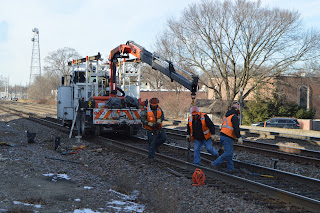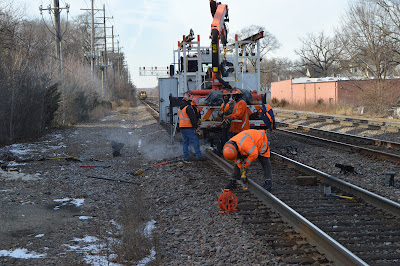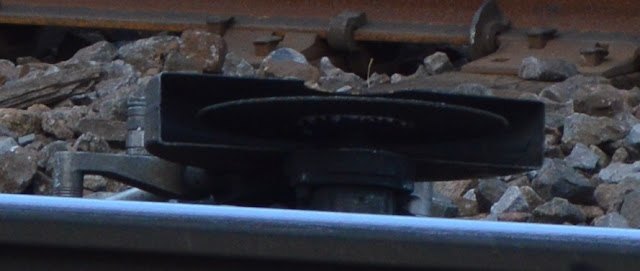On 2017 Dec 13 I caught them near the end of installing a short rail segment in the middle (M2) mainline track. I'll have some closeups of this later. At the time, I guessed that they were adding a segment of rail to lengthen it since I think they had a rail pull on M2 just a couple of days earlier.
 |
| 20171213 8765c |
 |
| 20171214 8794 12:08:46 BNSF #5305 and #8006 |
They were getting ready to cut the replacement rail to length. Note the crane is not in its parked position because it was used to get this rail off the rack on top of the truck. And it will soon be used again to pick up the two pieces of rail.
The lights in the background are for a ballast regulator that is helping a tamper level the track. That is, BNSF is making good use of a maintenance window on a mainline track by having different crews fix different problems at the same time.
When they started cutting at 12:11:44, I switched to video.
(new window)
12:14:14 I let the video run long enough that you could see how quickly they made progress. Then I walked around to get shots of the action from different angles. Note I carefully stayed at least 15 feet from the track because that is the normal boundary line for a railroad. You can see the sparks flying down below the rail he is cutting. The tool is powered by hydraulic hoses that come off a winch at the tail of the truck.
12:15:16 All done.
12:15:48 Then they moved the crane to pick up the new rail.
12:16:02
(new window)
12:17:50
The bells you heard at the end of the video were the crossing gates. I took a picture because I could not see any trains coming in either direction.
12:18:14 As with all crane work, the last couple of inches take most of the time.
12:18:18 As I suspected, the new signalling equipment they installed in 2014 is still having false closings. (The old signalling equipment did not have a single one in the almost 40 years that I saw them operate.) At least this false closure was relatively quick --- about a half-minute.
The two guys are pulling the scrap rail toward the truck to get it within the reach of the crane boom.
The boom is extended and...
...swung over to...
...grab the scrap rail.
(new window)
12:27:34 They have switched the hydraulic hoses from the rivet hammer to the bolt-hole drill and are putting the drill in place.
12:28:28 The can hold the cutting oil, and you can easily see the blue smoke that the drill generates. The working on this end of the new rail is using a small grinder to dress the cut.
12:28:36 While drilling, a worker is using his foot on the lever to hold the tool in place.
12:29:02 Lifting the lever because they are done with that hole.
As they place the drill for the second hole, you can see the hole they just drilled to the left of the drill.
And we are smoking again. It looks like the man with the foot on the lever is taking advantage of the drill time and using his cell phone. And the worker on the left must have dropped the joint bar down behind the "lever man's" other foot. After looking closer, I see the worker on the other side of the rail is also applying pressure with his foot. I assume he is the one that is pushing the bit into the rail.
They did move to the side when this intermodal came by. They kept on drilling.
This worker has already added a clamp to the right side of the tie. He is using the sledgehammer to pound the clamp on the left side of the tie into position. Note the grinder tool is in the foreground. I can see some clamps setting on the ballast to the left of the grinder.
12:32:26 Done with the second hole.
While they were drilling, a worker came over and talked to me. He said that since this is a mainline track, they will put two holes in each side. A welding crew will come by during the night to weld the joint. I asked if they use a truck with a big attachment that comes out the rear or if they use thermite. He said they use thermite welding because the Holland welder is a non-union subcontractor.
 |
| Holland Welder |
Now that I have seen some of the hydraulic powered tools in action, I take a closer look at the work on M2 the previous day.
 |
| 20171213 8764c |
We see the tool that cuts the rail on the left. I think the next tool over is the impact wrench that is used to tighten the bolts that are used to hold the rail joint bar to the rails they just drilled.
I can't guess what the other gizmos are for. It appears the worker is verifying that the new joint has good conductivity. I assume the new signalling system work like the old one did --- it detects block occupancy by the wheels conducting electricity from one rail to the other and completing a track circuit. I've read that trains have to have a minimum number of units to insure that there are enough wheelsets (axles) to provide a good electrical connection between the rails. That would explain why the Hi-Rail trucks don't trip the crossing gates. They have to wait at Main Street for traffic to clear in both directions before they can cross.
Update:
 |
| Michael Matalis remembered from March 17, 2012 Times they are a changin'. I went over to Forest Ave in Downers Grove this morning, I'd heard that the crossovers in the area were going to be removed and I wanted to get some photos. As it turned out they were already at it, probably to take advantage of the weekend commuter lull. By the end of the summer all of the main line switches and the signal bridge above them will probably be gone. Robby Gragg They are taking everything here out except for the switches into the yard. |
 |
| Google Earth 8/2008 |
 |
| Google Earth 8/2008 |




























No comments:
Post a Comment